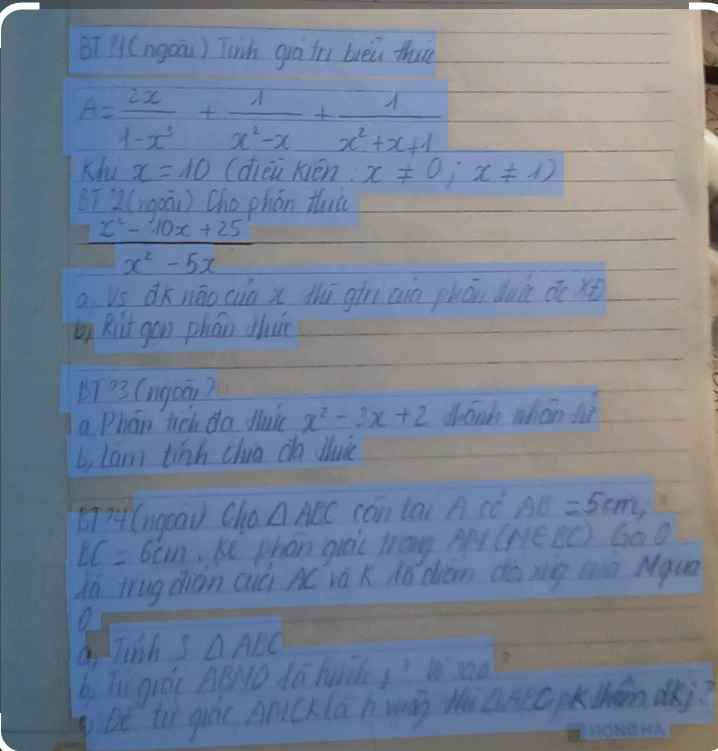
Hãy nhập câu hỏi của bạn vào đây, nếu là tài khoản VIP, bạn sẽ được ưu tiên trả lời.


a: \(\dfrac{2}{x+5}=\dfrac{2\cdot4\cdot\left(x-5\right)}{4\left(x-5\right)\left(x+5\right)}=\dfrac{8\left(x-5\right)}{4\left(x-5\right)\left(x+5\right)}\)
\(\dfrac{-3}{4x-20}=\dfrac{-3}{4\left(x-5\right)}=\dfrac{-3\left(x+5\right)}{4\left(x-5\right)\left(x+5\right)}=\dfrac{-3x-15}{4\left(x-5\right)\left(x+5\right)}\)
\(\dfrac{-x+2}{x^2-25}=\dfrac{-x+2}{\left(x-5\right)\left(x+5\right)}=\dfrac{4\left(-x+2\right)}{4\left(x-5\right)\left(x+5\right)}=\dfrac{-4x+8}{4\left(x-5\right)\left(x+5\right)}\)
b: \(\dfrac{1}{3x-6y}=\dfrac{1}{3\left(x-2y\right)}=\dfrac{\left(x-2y\right)\left(x+2y\right)}{3\left(x-2y\right)^2\cdot\left(x+2y\right)}\)
\(\dfrac{-x}{x^2-4y^2}=\dfrac{-x}{\left(x-2y\right)\left(x+2y\right)}\)
\(=\dfrac{-x\cdot3\cdot\left(x-2y\right)}{3\left(x-2y\right)^2\cdot\left(x+2y\right)}\)
\(\dfrac{-2y^2}{x^2-4xy+4y^2}=\dfrac{-2y^2}{\left(x-2y\right)^2}=\dfrac{-2y^2\cdot3\left(x+2y\right)}{3\left(x+2y\right)\left(x-2y\right)^2}\)
\(=\dfrac{-6y^2\left(x+2y\right)}{3\left(x+2y\right)\left(x-2y\right)^2}\)


`#3107.101107`
2.
a)
`(x - 2y)^2 = x^2 - 2*x*2y + (2y)^2 = x^2 - 4xy + 4y^2`
`=> -2xy -> -4xy`
b)
`(4a + 3b)^2 = (4a)^2 + 2*4a*3b + (3b)^2 = 16a^2 + 24ab + 9b^2`
`=>` `a^2 -> 16a^2`; `b^2 -> 9b^2`
c)
`9x^2 + 6xy + y^2 = (3x)^2 + 2*3x*y + y^2 = (3x + y)^2`
`=>` `(3x - y)^2 -> (3x + y)^2`
d)
`(a - 2b)^3 = a^3 - 3*a^2*2b + 3*a*(2b)^2 - (2b)^3 = a^3 - 6a^2b + 12ab^2 - 8b^3`
`=>` `-8a^2b -> -6a^2b`; `6ab^2 -> 12ab^2.`
Sử dụng các HĐT:
1) \(\left(A+B\right)^2=A^2+2AB+B^2\)
2) \(\left(A-B\right)^2=A^2-2AB+B^2\)
3) \(\left(A-B\right)^3=A^3-3A^2B+3AB^2-B^3\)
Làm bài này bạn chú ý cả 2 vế xem có phân tích được ra HĐT hoặc chỉnh ntnao cho đúng vs HĐT nha :v.

a) Ta có: \(\left(x-1.5\right)^6+2\left(1.5-x\right)^2=0\)
\(\Leftrightarrow\left(x-1.5\right)^2\left[\left(x-1.5\right)^4+2\right]=0\)
\(\Leftrightarrow x-1.5=0\)
hay x=1,5
b) Ta có: \(2x^3+3x^2+2x+3=0\)
\(\Leftrightarrow\left(2x+3\right)\left(x^2+1\right)=0\)
\(\Leftrightarrow2x+3=0\)
hay \(x=-\dfrac{3}{2}\)

Bài 33:
a: \(x^2-3x+2=\left(x-2\right)\left(x-1\right)\)

3d.
$(2x+5)^2=9x^2$
$\Leftrightarrow (2x+5)^2-(3x)^2=0$
$\Leftrightarrow (2x+5-3x)(2x+5+3x)=0$
$\Leftrightarrow (-x+5)(5x+5)=0$
$\Leftrightarrow -x+5=0$ hoặc $5x+5=0$
$\Leftrightarrow x=5$ hoặc $x=-1$
3b.
$x(x-2023)-2x+4046=0$
$\Leftrightarrow x(x-2023)-2(x-2023)=0$
$\Leftrightarrow (x-2023)(x-2)=0$
$\Leftrightarrow x-2023=0$ hoặc $x-2=0$
$\Leftrightarrow x=2023$ hoặc $x=2$
3c.
$x^2+5x+\frac{25}{4}=0$
$\Leftrightarrow x^2+2.x.\frac{5}{2}+(\frac{5}{2})^2=0$
$\Leftrightarrow (x+\frac{5}{2})^2=0$
$\Leftrightarrow x+\frac{5}{2}=0$
$\Leftrightarrow x=\frac{-5}{2}$

\(A=\left(x-3\right)^2-\left(2x+1\right)^2\)
\(=\left(x-3-2x-2\right)\left(x-3+2x+1\right)\)
\(=-\left(x+5\right)\left(3x-2\right)\)

Câu 18: B
Câu 19: B
Câu 20: D
Câu 21; D
Câu 22: B
Câu 23: B
Câu 24: A







a: Xét tứ giác AEDF có
AE//DF
AF//DE
Do đó: AEDF là hình bình hành
Hình bình hành AEDF có AD là phân giác của góc EAF
nên AEDF là hình thoi
b: Xét ΔBAC có AD là phân giác
nên \(\dfrac{AB}{AC}=\dfrac{BD}{DC}\left(1\right)\)
Xét ΔBAC có DF//AC
nên \(\dfrac{BD}{DC}=\dfrac{BF}{FA}\left(2\right)\)
Từ (1),(2) suy ra \(\dfrac{AB}{AC}=\dfrac{BF}{FA}\)
=>\(AB\cdot AF=BF\cdot AC\)